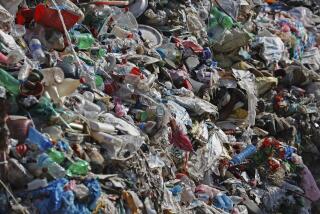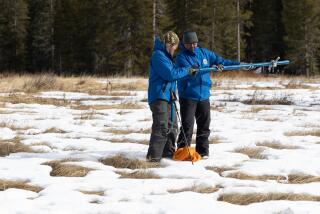Climate change may be baring Mt. Everest
- Share via
A warming climate is melting the glaciers of Mount Everest, shrinking the frozen cloak of Earth’s highest peak by 13% in the last 50 years, researchers have found.
Rocks and natural debris previously covered by snow are appearing now as the snow line has retreated 590 feet, according to Sudeep Thakuri, a University of Milan scientist who led the research.
The pessimistic view of Earth’s tallest peak was presented during a meeting Tuesday of the American Geophysical Union in Cancun, Mexico.
Researchers said they believe the observed changes could be due to human-generated greenhouse gases altering global climate, although their research has not established a firm connection.
The team reconstructed the glacial history of the area using satellite imagery and topographic maps of Everest and the surrounding 713-square-mile Sagarmatha National Park. Their statistical analysis shows that the majority of the glaciers in the national park are retreating at an increasing rate, Thakuri said.
Small glaciers of less than a square kilometer (about 247 acres), are vanishing fastest, registering a 43% decline in surface area since the 1960s.
Average temperatures have risen about 1 degree Fahrenheit since 1992, according data from the Nepal Climate Observatory stations and Nepal’s Department of Hydrology and Meteorology, the researchers found. Since 1992, precipitation has declined nearly four inches during the pre-monsoon and winter months, they found.
“The Himalayan glaciers and ice caps are considered a water tower for Asia since they store and supply water downstream during the dry season,” said Thakuri. “Downstream populations are dependent on the melt water for agriculture, drinking and power production.”
The topic of glacial melt in the Himalayas has been controversial. Initial reports by the Intergovernmental Panel on Climate Change predicted glaciers in the region would disappear by 2035. Subsequent analysis by the Gravity Recovery and Climate Experiment (GRACE) satellite mission showed that the melt was one-tenth the reported rate, and that some areas were experiencing growth, particularly in the Tibetan plateau.
Research published last year, however, showed that glaciers have been retreating over a 30-year period on the Tibetan plateau. It also showed that areas that depend on snow during regional monsoon seasons are particularly vulnerable to small rises in temperature.
The plateau is of concern because it is the ultimate source of drinking and irrigation water for more than 1 billion people in Asia.







